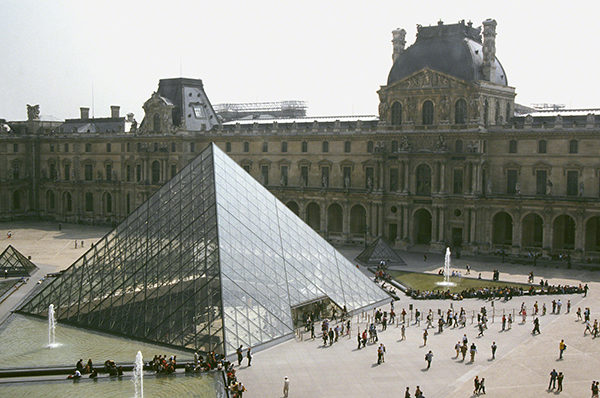AAPI Heritage Month 2022: I. M. Pei
I. M. (Ieoh Ming) Pei was a pioneering American architect renowned in the International Style. He conceived of many of his building designs as a form of sculpture.
 |
| I. M. Pei (1917–2019, U.S./born China), Louvre Pyramid, Paris, 1984–1988. Image © 2022 Davis Art Images. (8S-29795) |
Pei’s designs are elaborations on the rectangular forms and asymmetrical arrangements of the International Style. He transcends the style in the contrast of materials, arrangements of groups of geometric shapes, and dramatic arrangement of interior space.
The Louvre Pyramid is an example of how the Postmodern aesthetic melds perfectly with the International Style aesthetic. The project was controversial initially because Pei’s vision of a pyramid departs radically from the "traditional" ideas about an ancient Egyptian structure. However, the Louvre Pyramid is a clever introduction of an updated historical style in keeping with, yet not mimicking, the historic space of the Louvre that surrounds it.
The structure is also a sophisticated ode to the steel and glass box of the typical International Style. One of the striking features of the design is the light that the pyramid allows to flood underground levels of the museum, a consideration Pei used in his design for the National Gallery of Art East Building in Washington, DC, and the Miho Museum in Shiga, Japan.
While modern architecture of the second half of the 1900s in America was dominated by the International Style and the school of Frank Lloyd Wright (1867–1959), there were other avenues that were explored. The booming economies in the West after World War II (1939–1945) led to a boom in building on an unprecedented scale in the 1950s and 1960s. This boom encouraged some architects to look beyond the rectilinearity of the International Style and use the new structural systems such as ferro-concrete in innovative ways.
During this time, personal expression took precedence over the visual expression of function in some architects’ designs. With buildings extending beyond the geometric limitations of the International Style, some architects of this period presented structures with a dramatic, sculptural quality.
Of the many public building projects that offer architects the chance for innovative design, perhaps none is more challenging than designing a new museum or museum wing. This is due to the requirements that interior space be arranged for advantageous viewing of works of art. On the other hand, museum design is probably the easiest form in which the architect can abandon the dogma that characterizes the International Style—the idea that the building's function must be reflected in its form.
Pei is an example of an architect who, during the period of domination of the International Style, was able to refine and redefine modernist architectural expression repeatedly throughout his career. Instead of approaching each project with an established “look,” Pei was able to customize his designs to the project at hand with markedly varied results over the years. His career spanned the range from nominally International Style (Hancock Building, Boston) to Postmodernism (Louvre Pyramid, Paris) to expressive sculptural form (East Wing of the National Gallery).
Born and raised in China, Pei lived in Shanghai from the 1920s to the mid-1930s. His experience with the growth of that cityscape instilled in him a love of architecture. He moved to the U.S. in 1935 to study structural engineering and architecture at MIT, followed by studies at the Harvard Graduate School of Design. At Harvard he was introduced to the work of Europe’s leading architects. He absorbed their ideas for designing buildings in abstract shapes (like Le Corbusier) and buildings with exposed systems of support (like the Bauhaus/Walter Gropius).
During World War II, Pei developed modular, low-cost, pre-fab housing, the need of which was anticipated for returning veterans after the war. After graduate school, Pei taught as a professor at Harvard until 1948, when he became involved in several major urban redevelopment projects. In 1955, he initiated I. M. Pei & Associates, taking on large urban housing and commercial projects throughout the 1960s. While these buildings typically were executed in the International Style, reflecting the influence of Mies van der Rohe (1886–1969), he also designed other buildings that allowed him more artistic expression.
Correlations to Davis Programs: The Visual Experience 4E: Chapter 4 intro; Explorations in Art 2E Grade 1: 2.8; Explorations in Art 2E Grade 2: 6.1, 6.4; Explorations in Art 2E Grade 3: 4.2, 4.4; Explorations in Art 2E Grade 6: 4.1, 4.2


Comments